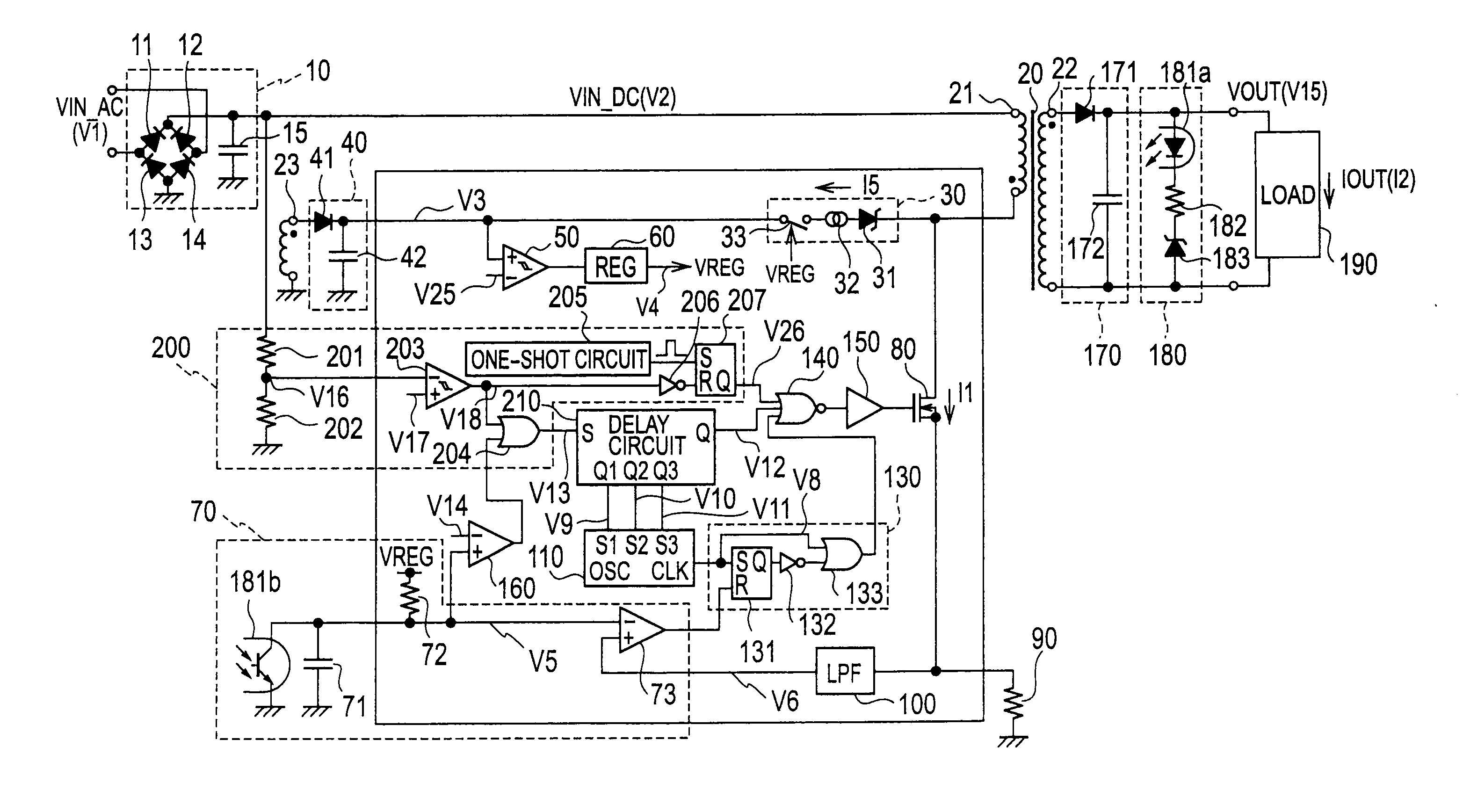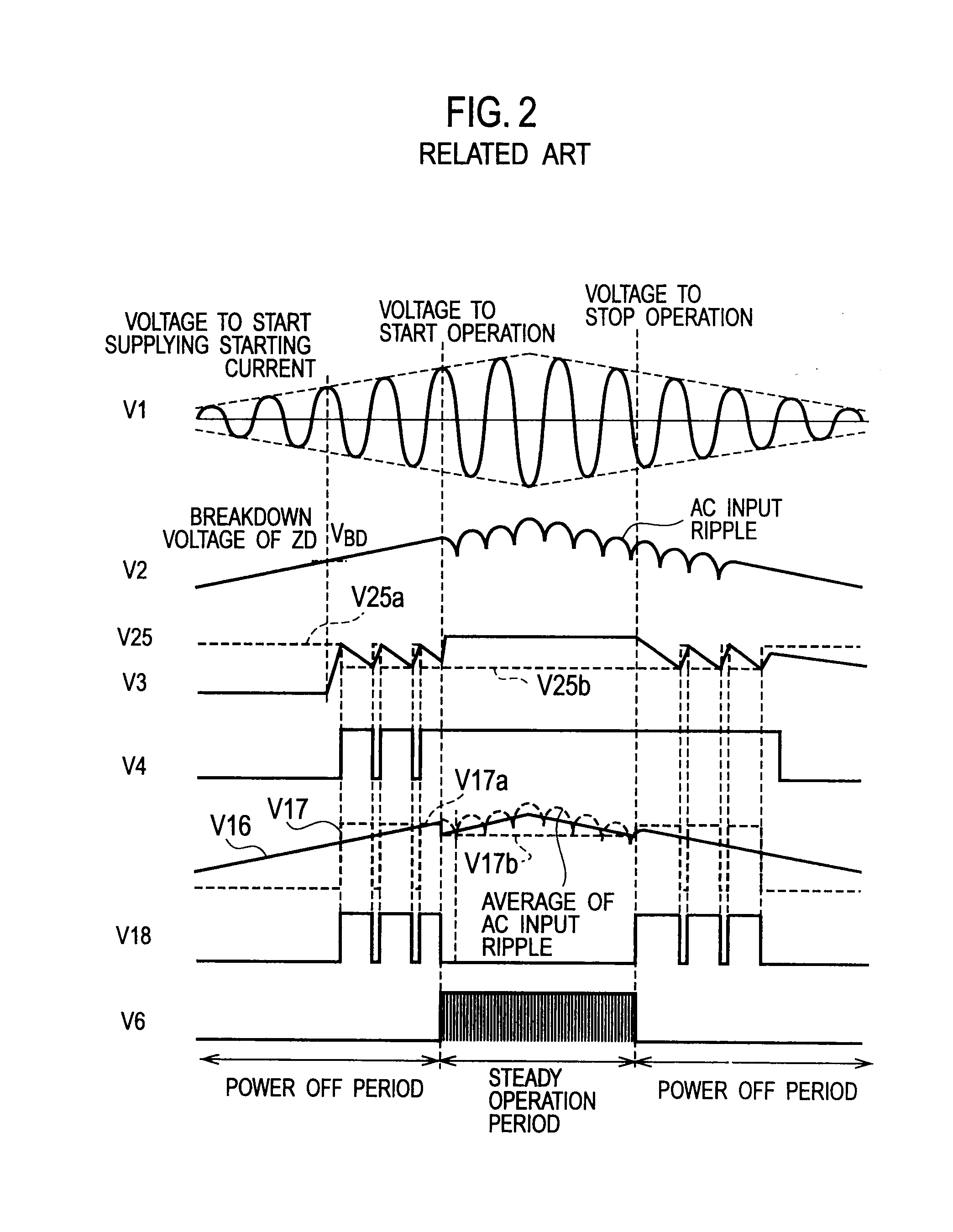Switching power source apparatus
a power source and power supply technology, applied in the direction of electric variable regulation, process and machine control, instruments, etc., can solve the problems of increasing costs and complicated circuit configuration, and achieve the effects of simple circuit configuration, simple circuit configuration, and complicated circuit configuration
- Summary
- Abstract
- Description
- Claims
- Application Information
AI Technical Summary
Benefits of technology
Problems solved by technology
Method used
Image
Examples
first embodiment
[0037]FIG. 3 is a circuit diagram showing a switching power source apparatus according to the first embodiment of the present invention. The apparatus includes an input rectifying-smoothing circuit 10, a transformer 20, a primary winding 21, a drive winding 23, a starter 30, a rectifying-smoothing circuit 40, a low-voltage-malfunction preventer 50, a reference voltage circuit 60, a feedback controller 70, a switching element 80, a current detecting resistor 90, a low-pass filter (LPF) 100, a first oscillator 110, a PWM controller 130, a NOR gate 140, a driver 150, a comparator 160, a low-input protective controller 200, a delay circuit 210, a rectifying-smoothing circuit 170, an output voltage detector 180, and a load 190.
[0038]The first embodiment of FIG. 3 differs from the related art of FIG. 1 in the circuit configuration of the low-input protective controller 200, delay circuit 210, and NOR gate 140.
[0039]Each part of the first embodiment will be explained. The input rectifying-...
second embodiment
[0083]FIG. 9 is a circuit diagram showing a switching power source apparatus according to the second embodiment of the present invention. The second embodiment of FIG. 9 differs from the first embodiment of FIG. 3 in that the second embodiment directly connects an input terminal of a voltage dividing resistor 201 to a voltage terminal of an AC voltage source and a connection point between diodes 12 and 14. The other parts of FIG. 9 are the same as those of FIG. 3, and therefore, are represented with the same reference marks.
[0084]According to the second embodiment of FIG. 9, the voltage dividing resistors 201 and 202 divide an AC voltage and provide a half-wave-rectified voltage to an inverting terminal of a comparator 203 so that the comparator 203 detects a peak value of the AC voltage. This configuration realizes a low-input protecting function like the first embodiment.
[0085]To detect an AC voltage, a power loss of the voltage dividing resistors 201 and 202 according to the seco...
third embodiment
[0086]FIG. 10 is a circuit diagram showing a switching power source apparatus according to the third embodiment of the present invention. The third embodiment of FIG. 10 differs from the second embodiment of FIG. 9 in that the third embodiment connects a diode 240 between a connection point of diodes 12 and 14 and an input terminal of a voltage dividing resistor 201. The other parts of FIG. 10 are the same as those of FIG. 9, and therefore, are represented with the same reference marks.
[0087]According to the third embodiment of FIG. 10, the diode 240 half-wave-rectifies an AC voltage V1 and the voltage dividing resistors 201 and 202 divide the half-wave-rectified voltage to provide a half-wave divided voltage, which is supplied to an inverting terminal of a comparator 203 so that the comparator 203 detects a peak value of the AC voltage. This configuration also realizes a low-input protecting function. Like the second embodiment of FIG. 9, the third embodiment can reduce the standby...
PUM
 Login to View More
Login to View More Abstract
Description
Claims
Application Information
 Login to View More
Login to View More - R&D
- Intellectual Property
- Life Sciences
- Materials
- Tech Scout
- Unparalleled Data Quality
- Higher Quality Content
- 60% Fewer Hallucinations
Browse by: Latest US Patents, China's latest patents, Technical Efficacy Thesaurus, Application Domain, Technology Topic, Popular Technical Reports.
© 2025 PatSnap. All rights reserved.Legal|Privacy policy|Modern Slavery Act Transparency Statement|Sitemap|About US| Contact US: help@patsnap.com



